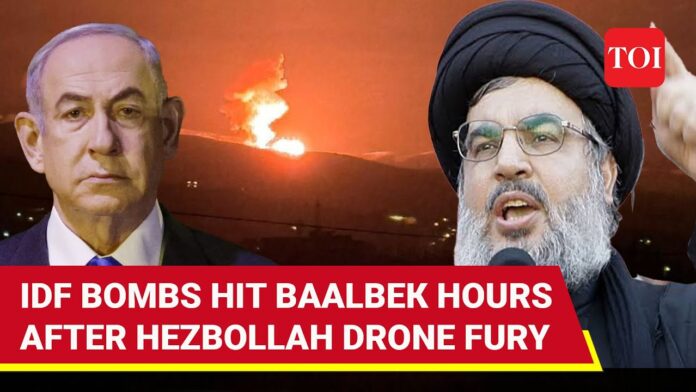Hezbollah retaliates with 60 rocket barrage at Mount Meron air traffic control base in northern Israel
The Israeli Defense Forces (IDF) conducted a drone strike in southern Lebanon on Tuesday night, killing Hussein Ibrahim Makki, a senior Hezbollah field commander. This action, confirmed by the IDF, prompted a retaliatory rocket barrage from Hezbollah, escalating tensions between the two adversaries.
Makki, identified as a top commander in Hezbollah’s Southern Front unit, previously led the group’s coastal division. The drone strike targeted him while he was driving near Tyre, resulting in his death and injuring two others, according to IDF and Lebanese media reports. Emergency responders confirmed the casualties.
Hezbollah acknowledged Makki’s death, referring to him as a martyr “on the road to Jerusalem,” a term the group uses for operatives killed in Israeli strikes. However, Hezbollah did not specify his role within the organization. The IDF highlighted Makki’s involvement in planning and executing numerous terror attacks against Israel, particularly during the ongoing conflict.
In retaliation, Hezbollah launched approximately 60 rockets from Lebanon into northern Israel on Wednesday morning, primarily targeting Mount Meron. The air traffic control base atop Mount Meron, situated about eight kilometres from the Lebanon border, has been a frequent target in the conflict. The IDF reported minor damage to the base but no injuries, as air defences intercepted several rockets.
Hezbollah claimed responsibility for the rocket barrage, stating that it aimed dozens of rockets at the Mount Meron base and additional projectiles at the Biranit army base near the border. The IDF confirmed the attack, noting that the retaliatory strike was in response to Makki’s assassination.
The escalation follows a series of skirmishes along the Israel-Lebanon border since October 8. Hezbollah-led forces have consistently targeted Israeli communities and military posts, citing support for Gaza amidst the broader regional conflict. These border clashes have resulted in the deaths of ten Israeli civilians and 14 IDF soldiers and reservists. Hezbollah has lost 298 members in the conflict, primarily in Lebanon, with some casualties in Syria. Additionally, 60 operatives from other terror groups, a Lebanese soldier, and at least 60 civilians have been killed in Lebanon.
In a separate incident, an Israeli civilian died, and five soldiers were injured in a Hezbollah anti-tank guided missile attack near Adamit in northern Israel. The ongoing conflict has seen various assaults from Hezbollah and other Iran-backed groups, including multiple drone attacks.
For the second consecutive night, the IDF reported downing two drones approaching Israeli territory from the east. These drones did not enter Israeli airspace. The Iran-backed Islamic Resistance in Iraq claimed responsibility for launching the drones toward Eilat, reflecting the broader regional dimensions of the conflict. Iran and its allied groups in Iraq and Syria have launched numerous drone attacks on Israel, with the IDF intercepting many. Last month, Iran executed an unprecedented attack on Israel with hundreds of drones and missiles.
The situation remains volatile, with significant implications for regional stability. The IDF and Hezbollah continue to engage in a tit-for-tat escalation, reflecting the deep-rooted and complex nature of their conflict.
analysis:
The targeted killing of Hussein Ibrahim Makki by the IDF marks a significant escalation in the ongoing conflict between Israel and Hezbollah. This incident highlights the complex interplay of military strategy, regional politics, and international relations shaping the Middle East’s security landscape.
From a political perspective, the assassination of a top Hezbollah commander underscores Israel’s commitment to neutralizing threats from its northern border. The IDF’s precision strike capabilities demonstrate its intent to disrupt Hezbollah’s command structure and operational planning. However, such actions also risk provoking broader retaliatory measures from Hezbollah, potentially drawing in other regional actors aligned with the group.
Economically, the conflict strains resources on both sides. Israel invests heavily in defense technology, including its Iron Dome missile defense system, to protect civilian and military targets. The costs associated with continuous military readiness and infrastructure repair, alongside potential economic sanctions or disruptions, can impact the national economy. Conversely, Hezbollah’s financial resources, often supported by Iran, are similarly stretched as it engages in prolonged conflict.
Sociologically, the conflict perpetuates a cycle of violence and instability affecting civilian populations in both Lebanon and Israel. The constant threat of rocket attacks and military strikes creates an environment of fear and uncertainty. In Lebanon, the civilian casualties and displacement exacerbate existing socio-economic challenges, while in Israel, the repeated disruptions to daily life affect public morale and social cohesion.
From a gender perspective, conflicts disproportionately impact women and children, who face heightened risks of violence, displacement, and loss of livelihoods. The ongoing hostilities limit access to essential services and exacerbate vulnerabilities among these populations, highlighting the need for targeted humanitarian interventions.
Locally, the conflict’s immediate impact on communities near the Israel-Lebanon border is profound. Residents face regular evacuations, property damage, and disruptions to daily life. The psychological toll of living under constant threat cannot be overstated, affecting mental health and community resilience.
Theoretically, the conflict between Israel and Hezbollah can be analyzed through the lens of asymmetric warfare, where state and non-state actors engage in prolonged, low-intensity conflict. Hezbollah’s tactics, including rocket barrages and guerrilla warfare, aim to exploit Israel’s vulnerabilities despite its technological and military superiority. This dynamic underscores the challenges of achieving lasting peace and security in the region.
In conclusion, the killing of Hussein Ibrahim Makki and the subsequent escalation with Hezbollah reflect the deep-seated and multifaceted nature of the Israel-Hezbollah conflict. Addressing this conflict requires not only military strategies but also diplomatic efforts, regional cooperation, and humanitarian support to mitigate the broader impacts on civilian populations and regional stability.
